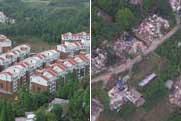China
About $860 mln needed to renovate quake-damaged relic sites in China
Source: Xinhua | 06-06-2008 21:42
Special Report: Strong quake jolts SW ChinaBEIJING, June 6 (Xinhua) -- About 6 billion yuan (857 million U.S. dollars) will be needed to renovate and protect the cultural relics sites damaged in the magnitude-8.0 tremor, according to China's State Administration of Cultural Heritage here on Friday.
A total of 169 cultural relic sites under state protection and 250 provincial-level ones in seven provinces and municipalities suffered damages of various degrees during the May 12 quake, Shan Jixiang, the administration director, said at a press conference.
In total, 2,766 relics were damaged, of which 292 were considered very precious, the official said.
Shan said it would take at least five years to renovate and rebuild the damaged relics in the quake-hit areas.
The quake affected provinces included as far as north in Shanxi Province, with one cultural heritage under state protection and one provincial-level relic site damaged to some degree, said the administration official.
The southwestern Sichuan, northwestern Shaanxi and Gansu provinces, places that have boasted long histories and ancient civilizations for millenniums, were among the worst hit after the quake.
Cultural relics in seven cities and 35 counties were affected in Shaanxi Province. All told, 29 cultural relics sites under state protection and 17 provincial-level ones were affected, while 308 pieces of relics were damaged, of which 41 were considered very precious.
In Sichuan, 83 cultural relics sites under state protection and 174 provincial-level ones were damaged, with 1,839 museum pieces affected, among which 189 were considered rare.
Many ancient buildings, including the Erwang Temple, a structure built 2,000 years ago to honor builders of the world's oldest irrigation project Dujiangyan, have collapsed.
Dujiangyan is still in operation but cracks have been reported in some parts.
Shan said temporary reconstruction efforts would be focused on the renovation of Erwang Temple and experts from Qinghua University in Beijing were clearing the building's debris and doing preparations for rebuilding.
The reconstruction and renovation will mostly feature re-use of the materials left after the tremor and laying solid quake-proof ground work, he said.
The official added he was a bit relieved to see that most of the well-known cultural heritage sites were not severely damaged.
Enlisted as World Heritage sites, the irrigation project Dujiangyan was not at risk and still operational. The Dazu Rock Carvings in Chongqing, Sichuan's neighboring municipality, stood up to the quake and an 800-year-old rock carving -- the "Qianshou"("A Thousand Hands") Guanyin (Buddhist) statue was intact, said the official.
Cracks were found on some terracotta warriors in northwestern Shaanxi Province but the damage was not serious. The Yingxian Wooden Tower of Shanxi, the world's tallest wooden structure, was not affected, he said.
One of the most pressing tasks for now was to save and put in order some cultural relics. Many of their components were buried under the collapsed buildings. The speed in repairing endangered cultural relic structures and warehouses that have large stocks of precious pieces also need to get quicker, he said.
Damages of cultural relics were also reported in Yunnan and Hubei provinces.
Editor:Zhang Ning



